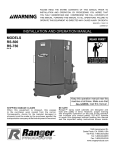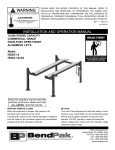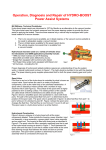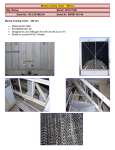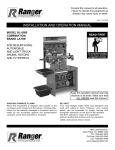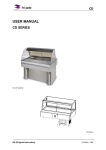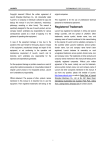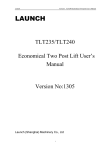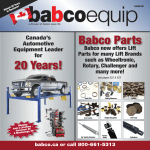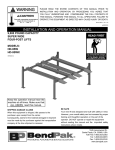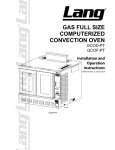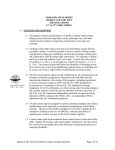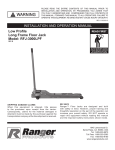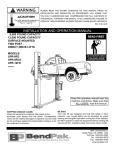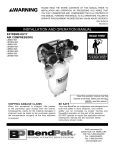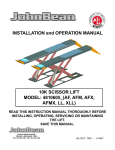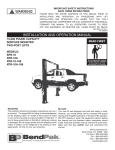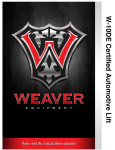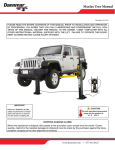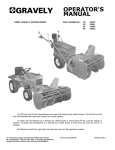Download Attachment - Alpha Omega
Transcript
PLEASE READ THE ENTIRE CONTENTS OF THIS MANUAL PRIOR TO INSTALLATION AND OPERATION. BY PROCEEDING YOU AGREE THAT YOU FULLY UNDERSTAND AND COMPREHEND THE FULL CONTENTS OF THIS MANUAL. FORWARD THIS MANUAL TO ALL OPERATORS. FAILURE TO OPERATE THIS EQUIPMENT AS DIRECTED MAY CAUSE INJURY OR DEATH. REV B 07-09-10 p/n 5900161 INSTALLATION AND OPERATION MANUAL 14,000 POUND CAPACITY COMMERCIAL GRADE FOUR-POST LIFTS MODELS: HDS-14 HDS-14X Keep this operation manual near the machine at all times. Make sure that ALL USERS read this manual. SHIPPING DAMAGE CLAIMS When this equipment is shipped, title passes to the purchaser upon receipt from the carrier. Consequently, claims for the material damaged in shipment must be made by the purchaser against the transportation company at the time shipment is received. BE SAFE Your new lift was designed and built with safety in mind. However, your overall safety can be increased by proper training and thoughtful operation on the part of the operator. DO NOT operate or repair this equipment without reading this manual and the important safety instructions shown inside. 1645 Lemonwood Dr. Santa Paula, CA. 93060, USA Toll Free 1-800-253-2363 Tel: 1-805-933-9970 Fax: 1-805-933-9160 www.bendpak.com 14,000 POUND CAPACITY, COMMERCIAL GRADE FOUR POST AUTO / TRUCK LIFT This instruction manual has been prepared especially for you. Your new lift is the product of over 35 years of continuous research, testing and development; it is the most technically advanced lift on the market today. READ THIS ENTIRE MANUAL BEFORE INSTALLATION & OPERATION BEGINS. RECORD HERE THE LIFT AND POWER UNIT INFORMATION WHICH IS LOCATED ON THE SERIAL NUMBER DATA PLATES ON THE LIFT AND ON THE POWER UNIT Power Unit Model # Power Unit Date Of Mfg. Power Unit Serial # _____________ _____________ _____________ This information is required when calling for parts or warranty issues. PRODUCT WARRANTY BendPak 4-Post Lifts are covered under warranty for five years on equipment structure, to be free of defects in material and workmanship. Power units, hydraulic cylinders, and all other assembly components such as turnplates, slip plates, cables, chains, valves, switches etc. are covered under warranty for one year against defects in material or workmanship under normal use. BendPak Inc. shall repair or replace at their option for the warranty period those parts returned to the factory freight prepaid which prove upon inspection to be defective. BendPak Inc. will pay labor costs for the first 12 months only on parts returned as previously described. The warranty does not extend to... defects caused by ordinary wear, abuse, misuse, shipping damage, improper installation, voltage or lack of required maintenance; damages resulting from purchaser’s neglect or failure to operate products in accordance with instructions provided in the owner’s manuals) and/or other accompanying instructions supplied; normal wear items or service normally required to maintain the product in a safe operating condition; any component damaged in shipment; other items not listed but may be considered general wear parts; damage caused by rain, excessive humidity, corrosive environments or other contaminants. THESE WARRANTIES DO NOT EXTEND TO ANY COSMETIC DEFECT NOT INTERFERING WITH EQUIPMENT FUNCTIONALITY OR ANY INCIDENTAL, INDIRECT, OR CONSEQUENTIAL LOSS, DAMAGE, OR EXPENSE THAT MAY RESULT FROM ANY DEFECT, FAILURE, OR MALFUNCTION OF A BENDPAK INC. PRODUCT OR THE BREACH OR DELAY IN PERFORMANCE OF THE WARRANTY. WARRANTY IS NOT VALID UNLESS WARRANTY CARD IS RETURNED. 2 OWNER’S RESPONSIBILITY IMPORTANT NOTICE To maintain the lift and user safety, the responsibility of the owner is to read and follow these instructions: Do not attempt to install this lift if you have never been trained on basic automotive lift installation procedures. Never attempt to lift components without proper lifting tools such as forklift or cranes. Stay clear of any moving parts that can fall and cause injury. These instructions must be followed to insure proper installation and operation of your lift. Failure to comply with these instructions can result in serious bodily harm and void product warranty. Manufacturer will assume no liability for loss or damage of any kind, expressed or implied resulting from improper installation or use of this product. Follow all installation and operation instructions. Make sure installation conforms to all applicable Local, State, and Federal Codes, Rules, and Regulations; such as State and Federal OSHA Regulations and Electrical Codes. Carefully check the lift for correct initial function. Read and follow the safety instructions. Keep them readily available for machine operators. Make certain all operators are properly trained, know how to safely and correctly operate the unit, and are properly supervised. Allow unit operation only with all parts in place and operating safely. Carefully inspect the unit on a regular basis and perform all maintenance as required. Service and maintain the unit only with authorized or approved replacement parts. Keep all instructions permanently with the unit and all decals on the unit clean and visible. PLEASE READ ENTIRE MANUAL PRIOR TO INSTALLATION. DEFINITIONS OF HAZARD LEVELS Identify the hazard levels used in this manual with the following definitions and signal words: BEFORE YOU BEGIN Receiving: The shipment should be thoroughly inspected as soon as it is received. The signed bill of lading is acknowledgement by the carrier of receipt in good condition of shipment covered by your invoice. If any of the goods called for on this bill of lading are shorted or damaged, do not accept them until the carrier makes a notation on the freight bill of the shorted or damaged goods. Do this for your own protection. DANGER ! Watch for this symbol: It Means: Immediate hazards which will result in severe personal injury or death. NOTIFY THE CARRIER AT ONCE if any hidden loss or damage is discovered after receipt and request the carrier to make an inspection. If the carrier will not do so, prepare a signed statement to the effect that you have notified the carrier (on a specific date) and that the carrier has failed to comply with your request. WARNING ! Watch for this symbol: It Means: Hazards or unsafe practices which could result in severe personal injury or death. IT IS DIFFICULT TO COLLECT FOR LOSS OR DAMAGE AFTER YOU HAVE GIVEN THE CARRIER A CLEAR RECEIPT. File your claim with the carrier promptly. Support your claim with copies of the bill of lading, freight bill, invoice, and photographs, if available. Our willingness to assist in helping you process your claim does not make BendPak responsible for collection of claims or replacement of lost or damaged materials. CAUTION ! Watch for this symbol: It Means: Hazards or unsafe practices which may result in minor personal injury, product or property damage. 3 TABLE OF CONTENTS Contents Page No. Warranty / Serial Number Information . . . . . . . . . . . . . . . . . . . . . . . . . . . . . . . . . . . . . . . . . . .2 Definitions of Hazard Levels . . . . . . . . . . . . . . . . . . . . . . . . . . . . . . . . . . . . . . . . . . . . . . 3 Owner’s Responsibility . . . . . . . . . . . . . . . . . . . . . . . . . . . . . . . . . . . . . . . . . . . . . . .3 Before You Begin . . . . . . . . . . . . . . . . . . . . . . . . . . . . . . . . . . . . . . . . . . . . . . . 3 Installer Operator/ Protective Equipment . . . . . . . . . . . . . . . . . . . . . . . . . . . . . . . . . . . 5 Introduction . . . . . . . . . . . . . . . . . . . . . . . . . . . . . . . . . . . . . . . . . . . . . . . . . . . . . . 6 Safety / Warning Instructions . . . . . . . . . . . . . . . . . . . . . . . . . . . . . . . . . . . . . . . . . . . . . . . 6 Tools Required . . . . . . . . . . . . . . . . . . . . . . . . . . . . . . . . . . . . . . . . . . . . . . . . . . . . . . . . . . . .7 Step 1 / Selecting Site . . . . . . . . . . . . . . . . . . . . . . . . . . . . . . . . . . . . . . . . . . . . . . .7 Step 2 / Floor Requirements . . . . . . . . . . . . . . . . . . . . . . . . . . . . . . . . . . . . . . . . .7 Concrete Specifications . . . . . . . . . . . . . . . . . . . . . . . . . . . . . . . . . . . . . . . . . . 7 Assembly View / Description of Parts . . . . . . . . . . . . . . . . . . . . . . . . . . . . . . . . . . 8 Floor Plan / Specifications . . . . . . . . . . . . . . . . . . . . . . . . . . . . . . . . . . . . . . . . . . . . . . 9 Power Unit Location . . . . . . . . . . . . . . . . . . . . . . . . . . . . . . . . . . . . . . . .10 Step 3 / Column and Cross Tube Installation . . . . . . . . . . . . . . . . . . . . . . . . . . . . . . . . .11-12 Step 4 / Raising the Cross Tubes . . . . . . . . . . . . . . . . . . . . . . . . . . . . . . . . .12 Step 5 / Powerside Runway Installation . . . . . . . . . . . . . . . . . . . . . . . . . . . . . . .13 Step 6 / Offside Runway Installation . . . . . . . . . . . . . . . . . . . . . . . . . . . . . . . . . . . . . . . . . .13 Step 7 / Cable Sheave Installation . . . . . . . . . . . . . . . . . . . . . . . . . . . . . . . . . . . . . . .14 Step 8 Cable Installation . . . . . . . . . . . . . . . . . . . . . . . . . . . . . . . . . . . . . . . . . . 15-17 Step 9 / Power Unit Installation . . . . . . . . . . . . . . . . . . . . . . . . . . . . . . . . .17 Step 10 / Routing Hydraulic Hoses . . . . . . . . . . . . . . . . . . . . . . . . . . . . .17-19 Step 11 / Routing Air Lines . . . . . . . . . . . . . . . . . . . . . . . . . . . . . . . . . . . . . .20 Step 12 / Power Unit Hook Up . . . . . . . . . . . . . . . . . . . . . . . . . . . . . . . . . . . . . . . . 21-23 Step 13 / Inspecting Slack Safety Springs . . . . . . . . . . . . . . . . . . . . . . . . . . . . . . . .23 Step 14 / Lift Start Up / Final Adjustments . . . . . . . . . . . . . . . . . . . . . . . . . . . . . 23-24 Step 15 / Anchoring The Columns . . . . . . . . . . . . . . . . . . . . . . . . . . . . . . 24-25 Step 16 / Attaching Approach Ramps / Tire stops . . . . . . . . . . . . . . . . . . . . . . . . 25 Step 17 / Leveling System . . . . . . . . . . . . . . . . . . . . . . . . . . . . . . . . . . . . . . . . 26 Step 18 Bleeding . . . . . . . . . . . . . . . . . . . . . . . . . . . . . . . . . . . . . . . . . . . . . . . . . . . 27 Optional Equipment Installation . . . . . . . . . . . . . . . . . . . . . . . . . . . . . . . . . 28-29 Step 19 / Operation/ Maintenance . . . . . . . . . . . . . . . . . . . . . . . . . . . . . 30-35 Troubleshooting Guide . . . . . . . . . . . . . . . . . . . . . . . . . . . . . . . . . . . . . . . . . . . 36-38 Maintenance Notes. . . . . . . . . . . . . . . . . . . . . . . . . . . . . . . . . . . . . . . . . . . . . 39 Installation Form . . . . . . . . . . . . . . . . . . . . . . . . . . . . . . . . . . . . . . . . . . . . . . . . . . . . . . . . 40 Part Number Lists . . . . . . . . . . . . . . . . . . . . . . . . . . . . . . . . . . . . . . . . . . . . . 41-47 4 INSTALLER / OPERATOR PLEASE READ AND FULLY UNDERSTAND. BY PROCEEDING YOU AGREE TO THE FOLLOWING. Failure to follow danger, warning, and caution instructions may lead to serious personal injury or death to operator or bystander or damage to property. I have visually inspected the site where the lift is to be installed and verified the concrete to be in good condition and free of cracks or other defects. I understand that installing a lift on cracked or defective concrete could cause lift failure resulting in personal injury or death. Please read entire manual prior to installation. Do not operate this machine until you read and understand all the dangers, warnings and cautions in this manual. For additional copies or further information, contact: I understand that a level floor is required for proper installation and level lifting. I understand that I am responsible if my floor is of questionable slope and that I will be responsible for all charges related to pouring a new level concrete slab if required and any charges. BendPak Inc. / Ranger Products 1645 Lemonwood Dr. Santa Paula, CA. 93060 I understand that the lifts are supplied with concrete fasteners meeting the criteria of the American National Standard “Automotive Lifts - Safety Requirements for Construction, Testing, and Validation” ANSI/ALI ALCTV2006, and that I will be responsible for all charges related to any special regional structural and/or seismic anchoring requirements specified by any other agencies and/or codes such as the Uniform Building Code (UBC) and/or International Building Code (IBC). 1-805-933-9970 www.bendpak.com INSTALLER / OPERATOR PROTECTIVE EQUIPMENT Personal protective equipment helps makes installation and operation safer, however, it does not take the place of safe operating practices. Always wear durable work clothing during any installation and/or service activity. Shop aprons or shop coats may also be worn, however loose fitting clothing should be avoided. Tight fitting leather gloves are recommended to protect technician hands when handling parts. Sturdy leather work shoes with steel toes and oil resistant soles should be used by all service personnel to help prevent injury during typical installation and operation activities. Eye protection is essential during installation and operation activities. Safety glasses with side shields, goggles, or face shields are acceptable. Back belts provide support during lifting activities and are also helpful in providing worker protection. Consideration should also be given to the use of hearing protection if service activity is performed in an enclosed area, or if noise levels are high. I will assume full responsibility for the concrete floor and condition thereof, now or later, where the above equipment model(s) are to be installed. Failure to follow danger, warning, and caution instructions may lead to serious personal injury or death to operator or bystander or damage to property. I understand that Bendpak lifts are designed to be installed in indoor locations only. Failure to follow installation instructions may lead to serious personal injury or death to operator or bystander or damage to property or lift. THIS SYMBOL POINTS OUT IMPORTANT SAFETY INSTRUCTIONS WHICH IF NOT FOLLOWED COULD ENDANGER THE PERSONAL SAFETY AND/OR PROPERTY OF YOURSELF AND OTHERS AND CAN CAUSE PERSONAL INJURY OR DEATH. READ AND FOLLOW ALL INSTRUCTIONS IN THIS MANUAL BEFORE ATTEMPTING TO OPERATE THIS MACHINE. 5 INTRODUCTION 1. Carefully remove the crating and packing materials. CAUTION! Be careful when cutting steel banding material as items may become loose and fall causing personal harm or injury. 2. Check the voltage, phase and proper amperage requirements for the motor shown on the motor plate. Wiring should be performed by a certified electrician only. IMPORTANT SAFETY INSTRUCTIONS ! Read these safety instructions entirely! IMPORTANT NOTICE ! Do not attempt to install this lift if you have never been trained on basic automotive lift installation procedures. Never attempt to lift components without proper lifting tools such as forklift or cranes. Stay clear of any moving parts that can fall and cause injury. 1. READ AND UNDERSTAND all safety warning procedures before operating lift. 12. GUARD AGAINST ELECTRIC SHOCK. This lift must be grounded while in use to protect the operator from electric shock. Never connect the green power cord wire to a live terminal. This is for ground only. 2. KEEP HANDS AND FEET CLEAR. Remove hands and feet from any moving parts. Keep feet clear of lift when lowering. Avoid pinch points. 13. DANGER! The power unit used on this lift contains high voltage. Disconnect power at the receptacle before performing any electrical repairs. Secure plug so that it cannot be accidentally plugged in during service. 3. KEEP WORK AREA CLEAN. Cluttered work areas invite injuries. 4. Consider work area environment. Do not expose equipment to rain. DO NOT use in damp or wet locations. Keep area well lighted. 14. WARNING! RISK OF EXPLOSION. This has internal arcing or sparking parts which should not be exposed to flammable vapors. This machine should not be located in a recessed area or below floor level. 5. ONLY TRAINED OPERATORS should operate this lift. All non-trained personnel should be kept away from work area. Never let non-trained personnel come in contact with, or operate lift. equipment 15. MAINTAIN WITH CARE. Keep lift clean for better and safer performance. Follow manual for proper lubrication and maintenance instructions. Keep control handles and/or buttons dry, clean and free from grease and oil. 6. USE LIFT CORRECTLY. Use lift in the proper manner. Never use lifting adapters other than what is approved by the manufacturer. 7. DO NOT override self-closing lift controls. 16. STAY ALERT. Watch what you are doing. Use common sense. Be aware. 8. REMAIN CLEAR of lift when raising or lowering vehicle. 17. CHECK FOR DAMAGED PARTS. Check for alignment of moving parts, breakage of parts or any condition that may affect its operation. Do not use lift if any component is broken or damaged. 9. CLEAR AREA if vehicle is in danger of falling. 10. ALWAYS INSURE that the safeties are engaged before any attempt is made to work on or near vehicle. 18. NEVER remove safety related components from the lift. Do not use lift if safety related components are damaged or missing. 11. DRESS PROPERLY. Non-skid steel-toe footwear is recommended when operating lift. 6 TOOLS REQUIRED Rotary Hammer Drill or Similar 3/4” Masonry Bit Hammer 4 Foot Level Open-End Wrench Set: SAE/Metric Socket And Ratchet Set: SAE/Metric Hex-Key / Allen Wrench Set Large Crescent Wrench Large Pipe Wrench Crow Bar Chalk Line Medium Flat Screwdriver Tape Measure: 25 Foot Minimum Needle Nose Pliers NOTE: An air supply (30 PSI Min / 3 CFM Min.) will be required for the safety-lock mechanisms. See Step 11. IMPORTANT NOTICE ! These instructions must be followed to insure proper installation and operation of your lift. Failure to comply with these instructions can result in serious bodily harm and void product warranty. Manufacturer will assume no liability for loss or damage of any kind, expressed or implied resulting from improper installation or use of this product. PLEASE READ ENTIRE MANUAL PRIOR TO INSTALLATION! A level floor is suggested for proper use and STEP 1 installation and level lifting. If a floor is of questionable (Selecting Site) Before installing your new lift, check the following. slope, consider a survey of the site and/or the possibility of pouring a new level concrete slab. 1. LIFT LOCATION: Always use architects plans when available. Check layout dimension against floor plan requirements making sure that adequate space if available. DO NOT install or use this lift on any asphalt surface or any surface other than concrete. 2. OVERHEAD OBSTRUCTIONS: The area where the lift will be located should be free of overhead obstructions such as heaters, building supports, electrical lines etc. DO NOT install or use this lift on expansion seams or on cracked or defective concrete. 3. DEFECTIVE FLOOR: Visually inspect the site where the lift is to be installed and check for cracked or defective concrete. DO NOT install or use this lift on a second / elevated floor without first consulting building architect. DO NOT install or use this lift outdoors. CONCRETE SPECIFICATIONS 4. OPERATING TEMPERATURE. Operate lift only between temperatures of 41° -104° F. LIFT MODEL 5. Lift is designed for INDOOR INSTALLATION ONLY. HDS-14 HDS-14X CONCRETE REQUIREMENTS 4” Min. Thickness / 3,000 PSI 4” Min. Thickness / 3,000 PSI STEP 2 (Floor Requirements) DANGER ! All models MUST be installed on 3000 PSI concrete only conforming to the minimum requirements shown above. New concrete must be adequately cured by at least 28 days minimum. This lift must be installed on a solid level concrete floor with no more than 3-degrees of slope. Failure to do so could cause personal injury or death. IMPORTANT NOTE: BendPak lifts are supplied with installation instructions and concrete fasteners meeting the criteria as prescribed by the American National Standard "Automotive Lifts - Safety Requirements for Construction, Testing, and Validation" ANSI/ALI ALCTV-2006. Lift buyers are responsible for any special regional structural and/or seismic anchoring requirements specified by any other agencies and/or codes such as the Uniform Building Code (UBC) and/or International Building Code (IBC). 7 8 Assembly View FLOOR PLAN *IMPORTANT NOTE* Check Diagonal Measurements To Ensure Square Layout Diagonal Measurements Must Be Equal. MODEL Lifting Capacity HDS-14 HDS-14X 14,000 /6350 Kg. 14,000 Lbs. / 6350 Kg. Max Capacity Front Axle 7,000 lbs. / 3175 Kg. 7,000 lbs. / 3175 Kg. Max Capacity Rear Axle 7,000 lbs. / 3175 Kg. 7,000 lbs. / 3175 Kg. A - Overall Width 130”/ 3300 mm 130”/ 3300 mm B- Outside Length 213” / 5408 mm 243” / 6170 mm C- Overall Length 241” / 6131 mm 271” / 6894 mm D- Height of Columns 92” / 2338 mm 92” / 2338 mm E- Min Runway Height 7.5” / 192mm 7.5” / 192 mm F- Max. Rise 70” / 1778 mm 70” / 1778 mm G- Max Lifting Height 77.5” / 1970 mm 77.5” / 1970 mm H- Width Between Columns 120” / 3046 mm 120” / 3046mm 20” / 508 mm 20” / 508 mm 37.5” - 50” 953 mm - 1289mm 37.5” - 51.5” 953 mm - 1310mm I- Runway Width J - Width Between Runways(*) K- Length of Runways 199” / 5054 mm 236” 5816 mm Min. Wheelbase @ Rated Capacity 140” / 3556 mm 170” / 4318 mm Min. Wheelbase @ 75%Rated Capacity 120” / 3048 mm 145” / 3683 mm Min. Wheelbase @ 50%Rated Capacity 100” / 2540 mm 120” / 3048 mm Min. Wheelbase @ 25%Rated Capacity 80” / 2032 mm 95” / 2413 mm 13 13 Every 4” / 102 mm Every 4” / 102 mm 60 Seconds 60 Seconds 220 VAC / 60Hz 1 Ph. 220 VAC / 60Hz 1 Ph. Locking Positions Lock Spacing Lifting Time Standard Motor(**) * This dimension may be limited with the addition of rolling jacks. See Rolling Jack Specifications on Separate page. ** Special Voltages Available upon Request. The design, material and specifications are subject to change without notice. 9 POWER UNIT LOCATION IMPORTANT NOTE ! The Power Unit can be located at either “X” location shown below. It is important to locate the POWERSIDE runway (with cylinder) on the SAME SIDE as the Power Unit location. Each Runway MUST be installed with the Utility Rails to the inside. For the remainder of this instruction we will illustrate the Power Unit mounted at the DRIVER-SIDE (LEFT) FRONT column - TOP ILLUSTRATION. For Power Unit at right rear, rotate lift 180° leaving approach Ramps and Front Tire Stops in original position. 10 STEP 3 (Column & Cross Tube Installation) 1. Place a chalk line on the floor according to the floor plan layout. Pay attention to the Power Unit location. Locate and stand the Columns at their respective locations. DO NOT BOLT Columns down at this time. Use caution to prevent the Columns from falling over. (See Fig. 3.1) Fig 3.3 Fig 3.1 2. To estimate the shim requirements, place a target on floor at each Column position and record the readings. Find the highest of the four locations then find the difference between each of the remaining Columns. This difference is the estimated amount of shim thickness that will be required at each Column. (See Fig. 3.2) 4. With the Columns standing and the Cross Tubes in position, install the Safety Ladders. Pass the Ladders through the Column openings and drop down through the Slide Block guide slots on the cross tube until the Ladders come to rest on the Base Plates. DO NOT BOLT Columns down at this time. (See Fig. 3.4 - 3.5) Fig 3.2 Note: The maximum shim thickness recommended by the factory is no more than 1/2” per Column using shims and anchors provided with the lift. A maximum shim thickness of 2” is possible by ordering optional Shim Plates. Contact your authorized BendPak Distributor for ordering information. Fig 3.4 Fig 3.5 3. Using a forklift or crane, raise the Cross Tubes (making sure the Plastic Slide Blocks are still in position) and drop down into the top of the Columns. NOTE: The sheave windows should be positioned inward and adjacent the Power unit Column. (See Fig. 3.3) 11 5. The Columns and Cross Tubes will now be in position and spaced properly for the runways. 2. Manually raise the Cross Tubes until the Primary Safety Locks engage and rest on the lock position second down from the top of the Ladder or approximately 66” off the ground. It is important that the SLACK SAFETY LOCK IS CLEARED. The Slack Safety Lock must never rest on the Safety Ladder. (See Fig. 4.1 -4.3) 6. Install the column TOP CAPS using the M16 X 2 Hex Bolts, nuts & washers. Install the nut on each Safety Ladder until 1/2” of threads are exposed and the Ladder is raised at least 1/2” off of the base of the Column. NOTE: Raise the Ladder at least 1/2” off of the base of the column or damage to the lift will occur. Be sure to position the Cable hole INWARD. (See Fig. 3.6 - 3.7) Fig 4.1 Fig 3.6 Fig 4.2 Fig 3.7 Fig 4.3 STEP 4 3. The Columns and Cross Tubes will now be in position and spaced properly for the Runways. Be very careful not to disturb the Columns and Cross Tubes at this time as they may tip over causing personal injury or harm. (See Fig. 4.4) (Raising The Cross Tubes) 1. Before proceeding it will be necessary to first raise the Cross Tubes off the ground to facilitate Cable routing and final assembly. Fig 4.4 DANGER ! Be careful not to disturb the Columns and Cross Tubes as they may tip over causing personal injury or harm. IMPORTANT NOTE ! It is important that the SLACK SAFETY LOCK IS CLEARED. The slack safety lock must never rest on the safety ladder. 12 STEP 5 4. Position the Powerside Runway on top of the Cross Tubes with the Utility Rail towards the center. The fitting holes located at the side of the Powerside Runway should be adjacent to the Power Unit Column. Align the holes in the runway with the holes on the Cross Tubes and bolt together using four M12 x 1.75 x 90 hex bolts and washers. Tighten to 80 ftl/lbs. (See Fig. 5.5) (Powerside Runway Installation) 1. Locate the Powerside Runway easily identified by the Cylinder and sheave roller mounting structures welded on the underside. The Powerside Runway will be positioned on the side of the lift where the power unit is installed. (See Fig. 5.1) Fig 5.1 Fig 5.5 2. Install Cylinder and Cable Block as shown. (See Fig. 5.2-5.3) Fig 5.2 STEP 6 (Offside Runway Installation) 1. Position the Offside Runway on top of the Cross Tubes with the Utility Rail located inside. (See Fig. 6.1) Fig 5.3 3. Remove any pre-installed Cable Sheaves and Spacers from the Powerside Runway making sure to pay attention to the order in which they are removed. Remove the Sheave Pin Retaining Screws, then Remove Pin and Sheaves. (This will help at the time of re-installation.) (See Page 14.) Fig 6.1 DANGER ! DO NOT PROCEED with Cable installation or go near the lift work area unless visual confirmation is made of ALL Safety Locks. ALL locks MUST be engaged before proceeding. Failure to comply with these instructions may result in severe personal injury or death. (See page 12.) Fig 5.4 13 STEP 7 (Sheave Installation) DANGER ! DO NOT PROCEED unless visual confirmation is made of ALL Safety Locks. ALL Locks MUST be engaged before proceeding. Failure to comply with these instructions may result in severe personal injury or death. (See page 11.) Fig. 7.4 1. Inspect Cables to insure proper lengths. All Cables should have ID tags showing proper Cable lengths. Fig. 7.5 2. Review the Cable Routing Diagram below before beginning cable installation. (See Fig. 7.1) 3. In order to install the Cables it is necessary to first extend the Hydraulic Cylinder. Remove both Cylinder port plugs then use an air gun or come-along to extend the Cylinder. IMPORTANT! Be careful not to damage the chrome rod during this step. (See Fig. 7.2) Fig. 7.6 HELPFUL TIP Fig 7.2 Removing and replacing the Sheave Shaft to adjust the Sheaves during the installation of the Cables will allow for greater clearance when routing Cable ends. 4. You must reinstall the SHEAVES, AND PINS in the same order as they are removed.. (See Fig. 7.3 - 7.6) CAUTION! Use Caution as the Sheaves can fall and break if dropped. And be sure to install the locking Screw when adjustments and installation is complete. Fig 7.3 14 STEP 8 (Cable Installation) WARNING ! WHEN THE CABLE ADJUSTING NUTS BOTTOM OUT ON THE THREADED END OF THE CABLE CONNECTOR AND THERE IS STILL SLACK IN THE CABLES, THE CABLES HAVE STRETCHED BEYOND THE SAFE USEFUL LENGTH AND NEED TO BE REPLACED WITH FACTORY APPROVED CABLE ASSEMBLIES. DO NOT PLACE WASHERS, SPACERS OR OTHER DEVICES TO “SHORTEN” THE EFFECTIVE CABLE LENGTH AS DAMAGE TO THE LIFT OR INJURY TO PERSONS MAY OCCUR. Cable Routing Diagram Fig 8.1 A B C D Model HDS-14 HDS-14 HDS-14 HDS-14 Part # 5595065 5595066 5595074 5595075 Description HDS/HDSO-14/ 14LSX/14LSXE 12 x 4,100mm, Cable "A" HDS/HDSO-14/ 14LSX/14LSXE 12 x 5,732mm, Cable "B" HDS-14/14LSX 12 x 9,399mm, Cable "C" HDS-14/14LSX 12 x 10,964mm, Cable "D" A B C D HDS-14X HDS-14X HDS-14X HDS-14X 5595065 5595066 5595067 5595068 HDS/HDSO-14/ 14LSX/14LSXE 12 x 4,100mm, Cable “A” HDS/HDSO-14/ 14LSX/14LSXE 12 x 5,732mm, Cable “B” HDS-14 / 14LSXE 12 x 10,101mm, Cable "C" HDS-14 / 14LSXE 12 x 11,726mm, Cable "D" 15 1. The Cylinder Flange Plate MUST be installed with the Guide Assembly facing down and the Cylinder Retainer Plate on the outside of the guide. Lug ends of Cables start at Cylinder. (See Fig. 8.3) DANGER ! Failure to route lifting cables as described may lead to serious personal injury and/or death to operator or bystander and/or may cause damage to property. HELPFUL TIP Install the Sheaves and Cables in the order as shown below starting from the SHORTEST (A) to the LONGEST (D). Fig 8.2 Fig 8.3 2. Loosely route the Cables around the Sheaves, (refer to the diagram on page 14), and then install the Sheave Pin and screw in the Sheave Pin Retaining Screw. (It may be necessary to loosen the Sheave Pin and move or adjust the pulleys during Cable installation.) (See Fig. 8.4) Fig 8.4 3. Route the threaded Cable ends through the ends of each Cross Tube, over the Slack Safety Sheave then to the top of each Column. Secure using the M22 hex nuts and flat washers. Tighten each nut until there is at least one inch of threads protruding through the top of the nut. The Cables will remain loose until start up and final Cable adjustments are made. (See Fig. 8.5) Fig 8.5 16 STEP 9 3. Secure using the M22 Hex Nuts and Flat Washers. Tighten each nut until there is at least one inch of thread protruding through the top of the Nut. The Cables will remain loose until start up and final Cable adjustments are made. (See Fig.8.6) (Power Unit Installation) 1. Mount the Power Unit, the Flex Tube Mounting Bracket, the Vibration Dampener and the Air Valve Mounting Bracket to the Power Unit Mounting Bracket using the M8 hex bolts and nyloc nuts. (See Fig. 9.1) Fig 8.6 3. After routing the Cables double-check to make sure all are properly positioned and remain within the grooves of ALL Sheaves. (See Fig. 8.7 - 8.8) Fig 8.7 Fig 9.1 2. Fill the reservoir with 12 quarts of 10-WT hydraulic oil or Dexron III automatic transmission fluid. DANGER ! ALL WIRING MUST BE PERFORMED BY A LICENSED ELECTRICIAN. Fig 8.8 DANGER ! DO NOT PERFORM ANY MAINTENANCE OR INSTALLATION OF ANY COMPONENTS WITH OUT FIRST ENSURING THAT ELECTRICAL POWER HAS BEEN DISCONNECTED AT THE SOURCE OR PANEL AND CANNOT BE RE-ENERGIZED UNTIL ALL MAINTENANCE AND/OR INSTALLATION PROCEDURES ARE COMPLETED. CAUTION! Remember to tighten the Sheave Shaft Lock Screw. 17 The standard power unit for your lift is 220 volt, 60HZ, single phase. All wiring must be performed by a certified electrician only. SEE WIRING INSTRUCTIONS AFFIXED TO MOTOR FOR PROPER WIRING INSTRUCTIONS. DO NOT run power unit with no oil. Damage to pump can occur. The power unit must be kept dry. Damage to power unit caused by water or other liquids such as detergents, acid etc., is not covered under warranty. Operate lift only between temperatures of 41 °- 104° F. Improper electrical hook-up can damage motor and will not be covered under warranty. Motor can not run on 50HZ without a physical change in motor. Use a separate breaker for each power unit. Protect each circuit with time delay fuse or circuit breaker. For 208-230 volt, single phase, use a 25 amp fuse. For 208-230 volt, three phase, use a 20 amp fuse. For 380-440 volt, three phase, use a 15 amp fuse. STEP 10 (Routing Hydraulic Hoses) 1. Install the 90-degree hydraulic fitting to the POWER PORT and the 90* Air Fitting to the RETURN PORT of the Power unit and connect the Hydraulic Hoses as described below. It will be necessary to remove the shipping plugs from both ports prior to installing the Fittings. (See Fig. 10.1 - 10.2) Fig 10.2 Fig 10.1 NOTE: Check the Power Unit to determine proper connection ports for Power and Return lines. It will be necessary to remove shipping plugs from both ports prior to installing Fittings. 18 5. Connect Hoses as shown below making sure to pass through the retaining rings. MAKE SURE HOSES ARE KEPT CLEAR OF CABLES. (See Fig. 10.6 ) 2. Install the 90-degree Hydraulic Fittings in the port at the ram end of the cylinder. On the pipe thread side of the Fitting it is recommended to use Teflon tape or pipe sealer. DO NOT USE TEFLON TAPE on the JIC flared end. (See Fig. 10.3 ) Fig 10.6 Fig 10.3 6. Run the Power Unit Hydraulic Hose (90˚ fitting end towards HPU) and the Return Hydraulic Air line through the Flex Hose to the Power Unit. (See Fig. 10.7) 3. Install the 90-degree Air Fitting fitting in the port at the base end of the Cylinder. On the pipe thread side of the Fitting it is recommended to use Teflon tape or pipe sealer. (See Fig. 10.4) Fig 10.7 Fig 10.4 4. Install one end of Flex Hose to into hole in the POWERSIDE RUNWAY adjacent to the Power Unit. Install the other end of the Flex Hose to the Flex Hose Bracket Assy. Tighten securely. (See Fig. 10.5) 7. Connect the Power Unit Hydraulic Line (90˚ End) to the 90˚ Power Unit Fitting. Connect the Return Air Line to the 90˚ Air Fitting. (See Fig. 10.8) Fig 10.8 Fig 10.5 Fig 10.8 19 STEP 11 (Routing Air Lines) Route the air line as shown below making sure to position the push button air valve with the INLET facing towards the AIR SOURCE and the OUTLET facing the direction of the LIFT. A filter/regulator/lubricator must be installed on air supply at lift. Failure to do so will void the warranty. Cut the provided 1/4” air line tubing with a sharp blade to lengths as required. Tubing must be cut square with no burrs. Note: To assemble air line tubing into fitting, use firm, manual pressure to push tubing into the fitting until it bottoms out. To remove air line tubing from the fitting, hold push sleeve in (against fitting) and, at the same time, pull out on tubing. Pay careful attention to keep air line clear of any pinch points. Improper assembly may result in safety lock failure. An air supply (30 PSI Min / 3 CFM Min.) will be required for the safety-lock mechanisms. AIR PRESSURE SHOULD BE REGULATED TO 125 PSI MAX. (See Fig. 11.1) Fig 11.1 20 DANGER ! DO NOT PERFORM ANY MAINTENANCE OR INSTALLATION OF ANY COMPONENTS WITH OUT FIRST ENSURING THAT ELECTRICAL POWER HAS BEEN DISCONNECTED AT THE SOURCE OR PANEL AND CANNOT BE RE-ENERGIZED UNTIL ALL MAINTENANCE AND/OR INSTALLATION PROCEDURES ARE COMPLETED. IMPORTANT POWER-UNIT INSTALLATION NOTES DO NOT run power unit with no oil. Damage to pump can occur. The power unit must be kept dry. Damage to power unit caused by water or other liquids such as detergents, acid etc., is not covered under warranty. Improper electrical hook-up can damage motor and will not be covered under warranty. Motor can not run on 50HZ without a physical change in motor. Use a separate breaker for each power unit. Protect each circuit with time delay fuse or circuit breaker. For 208-230 volt, single phase, use a 25 amp fuse. For 208-230 volt, three phase, use a 20 amp fuse. For 380-440 volt, three phase, use a 15 amp fuse. Installation and adjustment. DO NOT attempt to raise vehicle until a thorough operation check has been completed. All wiring must be performed by a certified electrician only. SEE WIRING INSTRUCTIONS AFFIXED TO MOTOR FOR PROPER WIRING INSTRUCTIONS. 21 22 STEP 12 STEP 13 (Power Unit Hook Up) (Inspecting The Slack Safety Springs) 1. Have a certified electrician run the power supply to motor. Refer to the data plate found on the motor for proper power supply and wire size. The following steps involve the SLACK CABLE SAFETY DEVICE and MAIN SAFETY. Failure to follow these steps could result in serious injury or death in the event of cable failure. RISK OF EXPLOSION ! 1. Inspect the ends of the SLACK SAFETY LOCK SPRINGS as shown. Make sure the spring ends are secure at both ends. DO NOT ATTEMPT TO RAISE THE LIFT UNTIL THE SLACK SAFETY SPRINGS ARE ATTACHED AND THE ROLLERS ARE PULLED CLEAR FROM THE LADDER. (See Fig. 13.1) This equipment has internal arcing or parts that may spark and should not be exposed to flammable vapors. Motor should not be located in a recessed area or below floor level. NEVER expose motor to rain or other damp environments. DAMAGE TO MOTOR CAUSED BY WATER IS NOT COVERED UNDER WARRANTY. Fig 13.1 IMPORTANT NOTE: CAUTION Never operate the motor on line voltage less than 208V. Motor damage may occur which is not covered under warranty. Have a certified electrician run appropriate power supply to motor. Size wire for 25amp circuit. See Motor Operating Data Table. IMPORTANT: Use separate circuit for each Power Unit Protect each circuit with time delay fuse or circuit breaker. For single phase 208-230V, use 25 amp fuse. Three phase 208-240V, use 25 amp fuse. For three phase 400V and above, use 15 amp fuse. All wiring must comply with NEC and all local electrical codes. Fig. 12.1 STEP 14 ( Lift Start Up / Final Adjustments ) 1. Make sure the power unit reservoir is full with 12 quarts of 10-WT hydraulic oil or Dexron-III automatic transmission fluid. 2. Spray the inside of the Columns where the Slide Blocks glide with a light lubricant or WD-40. 3. Test the Power Unit by pressing the push-button switch. If the motor sounds like it is operating properly, raise the lift and check all hose connections for leaks. If the motor gets hot or sounds peculiar, stop and check all electrical connections. 4. Before proceeding, double-check to make sure all Cables are properly positioned within the grooves of ALL sheaves. Make sure all Cable Sheave Retaining Pins and/or clips are secure. 23 5. Check to make sure that all Slack Safety Locks are cleared and free. (See Fig. 14.1) KEEP HANDS AND FEET CLEAR. Remove hands and feet from any moving parts. Keep feet clear of lift when lowering. Avoid pinch points. 9. Check all MAIN SAFETY LOCKS to make sure they move freely and spring back to the lock position when released. Lubricate all SAFETY PIVOT points with WD-40 or equal. 10. Run the lift up and down a few times to insure that the locks are engaging uniformly and that the safety release mechanisms are functioning. Re-adjust if necessary. Fig 14.1 6. Continue pressing the raise button until the Cables get taught and the lift starts to move. 7. RAISE LIFT UNTIL THE CYLINDER BOTTOMS OUT AND THE LIFT STOPS. ADJUST EACH CABLE SO THAT EACH SAFETY LOCK RESTS AT ONE INCH ABOVE THE TOP SAFETY LOCK POSITION. It may be necessary to tighten or loosen each Cable to reach the proper height. The Cable Nuts MUST be tightened until there is at least one inch of threads protruding through the nut. (See Fig. 14.2) STEP 15 (Anchoring The Columns) 1. Before proceeding, double check the measurements and make certain that the bases of each Column are square and aligned with the chalk line. Raise the lift up and down and make sure it operates properly at the locations prescribed by the markings on the floor. (See Fig. 15.1) Fig 14.2 IMPORTANT NOTE: BendPak lifts are supplied with installation instructions and concrete fasteners meeting the criteria as prescribed by the American National Standard "Automotive Lifts - Safety Requirements for Construction, Testing, and Validation" ANSI/ALI ALCTV-2006. Lift buyers are responsible for any special regional structural and/or seismic anchoring requirements specified by any other agencies and/or codes such as the Uniform Building Code (UBC) and/or International Building Code (IBC). All Cable Nuts MUST be tightened on each end until there is at least one inch of threads protruding through the nut. Failure to do so could result in serious injury or death. NOTE: There will be initial stretching of the cables in the beginning and/or with increased loads. Adjust the Cables as outlined above a week after first use, then every three to six months thereafter depending on usage and/or to compensate for stretch. Fig. 15.1 2. Using the base plate on each Column as a guide, drill each anchor hole approximately 4-1/2” deep using a rotary hammer drill and 3/4” concrete bit. (See Fig. 15.2) 8. After connecting the air supply, press the PUSH BUTTON AIR VALVE and check that all safety locks are functioning properly. Lower the lift by pressing the push button air valve and power unit lowering valve simultaneously. 24 Fig. 15.2 Fig 15.5 3. After drilling, remove dust thoroughly from each hole using compressed air and/or bristle brush. Make certain that the Columns remain aligned with the chalk line. IMPORTANT ! If Anchor Bolts do hold when torqued to required amount, concrete must replaced. Saw cut and remove 24” x 24” square area each Column base then re-pour with reinforced 2500 concrete to a depth of six inches minimum, keying new concrete under existing floor. ALWAYS WEAR SAFETY GOGGLES. 4. Assemble the Washers and Nuts on the Anchors then tap each hole with a hammer until the washer rests against Base Plate. Be sure that if shimming is required, enough threads are left exposed. (See Fig. 15.3) STEP 16 (Attaching the Approach Ramp /Tire Stops) 1. Install the Approach Ramps on the entry side of the lift. Use the Top Pin Tube for HDS-14-SS-X (See Fig. 16.1) Fig 15.3 Fig 16.1 5. If shimming is required, insert the shims as necessary the base plate so that when the Anchor Bolts are tightened, the Columns will be plumb. (See Fig. 15.4) Fig 15.4 2. Install the Front Tire Stops at the forward side of the lift using the M14 x 2 hex bolts, nuts and washers. (See Fig. 16.2) 6. After any necessary shims are installed, tighten each nut to 35-45 ft./lbs. (See Fig. 15.5) Fig 16.2 25 STEP 17 Fig 17.2 (Leveling / Synchronizing) 1. Using an engineer’s automatic Level (transit), locate the Level, at a convenient location in the shop that allows an unobstructed view of all four corners of the Runways. 2. Follow the Level manufacturer’s instructions for proper setup of the Level. Be sure it is adjusted level in all -directions. 3. Raise the lift and lower the lift until all Primary Safeties are engaged on the FIRST Safety Stop in each Column and the Runways are completely resting on the Primary Safeties. 11. Next, load vehicle onto the lift. 12. Raise the lift to full height. Listen and watch as the Primary Safeties engage the safety ladder. Synchronize by adjusting the Cables so that all four latches click at same time. Make necessary adjustments to the Cables allowing compensation for stretch. 4.Place a Level target on the right/front corner of the Runway. (See Fig. 17.1) Fig 17.1 Safety Locks may not engage at exactly the same time when vehicles are being raised. They should be close. Be sure that all four corners have passed the SAME Safety Ladder bar slot before lowering lift on the safety locks. NEVER lower lift on different Safety Lock position or damage to the lift may result. 5. Beginning with “A” position, sight the level to the target and mark the number or the graduation on the inch scale of the target that aligns to the cross hairs of the Level. (See Fig. 17.1) Note: Use a pencil, marking pen or attach a paper clip onto the target scale at the cross hair reference. 13. Install the four Cross Tube Covers. (See Fig 17.3) 6. Next, move the target and place it at point “B” on the runway. (See Fig. 17.1) 7. Rotate the Level and focus on the target scale. 8. Adjust the adjustment nut on the safety ladder bar at the top of the Column at “B” until the cross hairs of the Level align to reference mark on the target scale. (See Fig. 17.1) Fig 17.3 9. Repeat steps locating the target assembly at points “C” and “D” and adjusting safety ladders at each corresponding Column until the reference mark on the target scale is on the cross hairs of the Level. The Runways are now level at all four points. (See Fig. 17.1) 10. To complete the leveling procedures, lock each safety ladder jam nut tightly against bottom of column top plate. (See Fig. 17.2) 26 STEP 18 POST-INSTALLATION CHECK-OFF (Bleeding) Columns Properly Shimmed And Stable 1. Lift must be fully lowered before changing or adding fluid. Anchor Bolts Tightened 2. Raise and lower lift six times. The Cylinder is selfbleeding. After bleeding system, fluid level in power unit reservoir may be down. Add more fluid if necessary to raise lift to full height. It is only necessary to add fluid to Raise lift to full height. Pivot / Sheave Pins Properly Attached Electric Power Supply Confirmed Cables Adjusted Properly 3. To pressure test, run lift to full rise and run motor for approximately 3-seconds after lift stops. This will place pressure on the hydraulic system. Stop and check all fittings and hose connections. Tighten or reseal if required. Safety Locks Functioning Properly Check For Hydraulic Leaks Oil Level Lubrication of Critical Components Check For Overhead Obstructions Runways Level All Screws, Bolts, and Pins Secured Surrounding Area Clean Operation, Maintenance and Safety Manuals on Site WARNING ! Wheels Chock must be used on the rear wheels. (See Fig 18.3) Fig 18.3 27 HD-9-12,12X,14,14X Series Rolling Jack Air Line Installation Kit Part # 5174009 REV 06-04-09 28 Adapter Plate Required for HD-9,12,14, HDS-14 Adapter Plate Required for HD-9,12,14, HDS-14 29 STEP 19 To Lower Lift; 1. Before lowering vehicle, be sure all personnel are clear of the lift and surrounding area. Pay careful attention to overhead clearances. Insure all tools and equipment have been cleared from under the lift. 2. Raise the lift off of the Safety Locks by pressing the push button on the Power Unit. Make sure you raise the lift by at least two inches to allow adequate clearance for the locks to clear. 3. Press the push button air safety valve and HOLD. 4. Push the LOWERING HANDLE on the Power Unit until the lift has descended completely. (Operation) To Raise Lift; 1. Position vehicle tires in the center of each Runway. 2. Set parking brake and use Wheel Chocks to hold vehicle in position. 3. Before raising vehicle, be sure all personnel are clear of the lift and surrounding area. Pay careful attention to overhead clearances. 4. Raise the lift to the desired height by pressing the push button on the power unit. When lowering the lift PAY CAREFUL ATTENTION that all personnel and objects are kept clear. ALWAYS keep a visual line of site on the lift AT ALL TIMES. ALWAYS make sure that all FOUR LOCKS are disengaged. If one of the locks inadvertently locks on descent the lift and/or vehicle may disrupt causing personal injury or death. DANGER ! VISUALLY CONFIRM THAT ALL PRIMARY SAFETY LOCKS ARE ENGAGED BEFORE ENTERING WORK AREA. Suspension components us on this lift are intended to raise and lower lift only and are not meant to be load holding devices. Remain clear of elevated lift unless visual confirmation is made that all Primary Safety Locks are fully engaged and the lift is LOWERED onto the Safety Locks, Refer to installation /operation manual for proper safety lock procedures and /or further instruction. WEEKLY MAINTENANCE 1. Lubricate all Sheave Pins with general purpose grease or WD-40 if no Zerk Fittings are present. 2. Check all Cable connections, bolts and pins to insure proper mounting. 3. Lubricate Safety Lock pivot points with general purpose oil or WD-40. MONTHLY MAINTENANCE 1. Check Safety Locks to insure they are in good operating condition. 2. Check all Cables for excessive signs of wear. 3. Make a visual inspection of ALL MOVING PARTS and check for excessive signs of wear. 4. Replace ALL FAULTY PARTS before lift is put back into operation. NEVER EXCEED THE RATED CAPACITY of lift. DO NOT USE LIFT if any component is found to be defective or worn. NEVER OPERATE LIFT with any person or equipment below. ALWAYS STAND CLEAR of lift when lowering or raising. ALWAYS INSURE SAFETY LOCKS ARE ENGAGED before entering work area. NEVER LEAVE LIFT IN ELEVATED CONDITION unless all four safety locks are engaged. Fig 19.1 5. After vehicle is raised to the desired height, lower the lift onto the nearest Safety Lock. Do not allow Cables to become slack. ALWAYS INSURE ALL SAFETY LOCKS ARE ENGAGED before entering work area. 30 WIRE ROPE INSPECTION AND MAINTENANCE Lifting cables should be replaced every three - five years or when visible signs of damage are apparent. DO NOT USE LIFT WITH DEFECTIVE / WORN CABLES. Lifting cables should be maintained in a well-lubricated condition at all times. Wire rope is only fully protected when each wire strand is lubricated both internal and external. Excessive wear will shorten the life of the wire rope. The factory suggested wire rope lubricant that penetrates to the core of the rope and provides long-term lubrication between each individual strand is 90-WT gear oil or ALMASOL® Wire Rope Lubricant. In order to make sure that the inner layers of the rope remain well lubricated, lubrication should be carried out at intervals not exceeding three months during operation. All sheaves and guide rollers in contact with the moving rope should be given regular visual checks for surface wear and lubricated to make sure that they run freely. This operation should be carried out at appropriate intervals generally not exceeding three months during operation. For all sheave axles, the factory recommends standard wheel bearing grease. For all sheaves and/or guide rollers, the factory recommends 90-WT gear oil or similar heavy lubricant applied by any method including pump / spray dispensing, brush, hand and/or swabbing. . HOW OFTEN TO INSPECT Lifting cables should be visually inspected at least once each day when in use, as suggested by American Petroleum Institute (API) RP54 guidelines. Any lifting cables that have met the criteria for removal must be immediately replaced. WHEN TO REPLACE LIFTING CABLES DUE TO BROKEN WIRES Lifting cables should be removed from service when you see six randomly distributed broken wires within any one lay length, or three broken wires in one strand within one lay length. OTHER REASONS TO REPLACE LIFTING CABLES Corrosion that pits the wires and/or connectors. Evidence of kinking, crushing, cutting, bird-caging or a popped core. Wear that exceeds 10% of a wire’s original diameter. Evidence of heat damage. HOW TO FIND BROKEN WIRES The first step is to relax your rope to a stationary position and move the pick-up points off the sheaves. Clean the surface of the rope with a cloth — a wire brush, if necessary — so you can see any breaks. Flex the rope to expose any broken wires hidden in the valleys between the strands. Visually check for any broken wires. One way to check for crown breaks is to run a cloth along the rope to check for possible snags. With an awl, probe between wires and strands and lift any wires that appear loose. Evidence of internal broken wires may require a more extensive rope examination. 31 32 33 Safe Lift Operation Automotive and truck lifts are critical to the operation and profitability of your business. The safe use of this and other lifts in your shop is critical in preventing employee injuries and damage to customer’s vehicles. By operating lifts safely you can insure that your shop is profitable, productive and safe. Safe operation of automotive lifts requires that only trained employees should be allowed to use the lift. TRAINING SHOULD INCLUDE, BUT NOT LIMITED TO: Proper positioning of the vehicle on the runway. (See manufacturers minimize wheel base loading requirements.) Use of the operating controls. Understanding the lift capacity. Proper use of jack stands or other load supporting devices. Proper use, understanding and visual identification of safety lock devices and their operation. Reviewing the safety rules. Proper housekeeping procedures (lift area should be free of grease, oil, tools, equipment, trash, and other debris) A daily inspection of the lift should be completed prior to its use. Safety devices, operating controls, lift arms and other critical parts should be inspected prior to using the lift. All maintenance and repairs of the lift should be completed by following the manufacturer’s requirements. Lift repair parts should meet or exceed OEM specifications. Repairs should only be completed by a qualified lift technician. The vehicle manufacturer’s recommendations should be used for spotting and lifting the vehicle. LIFT OPERATION SAFETY It is important that you know the load limit. Be careful that you do not overload the lift . If you are unsure what the load limit is, check the data plate found on one of the lift columns or contact the manufacturer. The center of gravity should be followed closely to what the manufacturer recommends. Always make sure you have proper overhead clearance. Additionally, check that attachments, (vehicle signs, campers, antennas, etc.) are not in the way. Be sure that prior to the vehicle being raised, the doors, trunk, and hood are closed securely Prior to being raised, make sure there is no one standing closer than six feet from the lift After positioning the vehicle on the lift runways, set the emergency brake, make sure the ignition is off, the doors are closed, overhead obstructions are cleared, and the transmission is in neutral. Double check that the automatic chock devices are in position and then when the lift is raised, observe the chocks Put pads or adapters in the right position under the contact points that have been recommended The lift should be raised just until the vehicle’s wheels are about one foot off the ground. If contact with the vehicle is uneven or it appears that the vehicle is not sitting secure, carefully lower the lift and readjust. Always consider potential problems that might cause a vehicle to slip, i.e., heavy cargo, undercoating, etc. Pay attention when walking under a vehicle that is up on the hydraulic lift. 34 DO NOT leave the controls while the lift is still in motion. DO NOT stand directly in front of the vehicle or in the bay when vehicle is being loaded or driven into position. DO NOT Go near vehicle or attempt to work on the vehicle when being raised or lowered. REMAIN CLEAR of lift when raising or lowering vehicle. DO NOT rock the vehicle while on the lift or remove any heavy component from vehicle that may cause excessive weight shift. DO NOT lower the vehicle until people, materials, and tools are clear ALWAYS INSURE that the safeties are engaged and lowered on to the safety ladders before any attempt is made to work on or near vehicle. Some vehicle maintenance and repair activities may cause the vehicle to shift. Follow the manufacturer’s guidelines when performing these operations. The use of jack stands or alternate lift points may be required when completing some repairs. READ AND UNDERSTAND all safety warning procedures before operating lift. KEEP HANDS AND FEET CLEAR. Remove hands and feet from any moving parts. Keep feet clear of lift when lowering. Avoid pinch points. ONLY TRAINED OPERATORS should operate this lift. All non-trained personnel should be kept away from work area. Never let non-trained personnel come in contact with, or operate lift. USE LIFT CORRECTLY. Use lift in the proper manner. Never use lifting adapters other than what is approved by the manufacturer. DO NOT override self-closing lift controls. CLEAR AREA if vehicle is on danger of falling. STAY ALERT. Watch what you are doing. Use common sense. Be aware. CHECK FOR DAMAGED PARTS. Check for alignment of moving parts, breakage of parts or any condition that may affect its operation. Do not use lift if any component is broken or damaged. NEVER remove safety related components from the lift. Do not use lift if safety related components are damaged or missing. When the lift is being lowered, make sure everyone is standing at least six feet away. Be sure there are no jacks, tools, equipment, left under the lift before lowering. Always lower the vehicle down slowly and smoothly. 35 LIFT WILL NOT RAISE POSSIBLE CAUSE 1. Air in oil, (1,2,8,13) 2. Cylinder binding, (9) 3. Cylinder leaks internally, (9) 4. Motor run backward under pressure, (11) 5. Lowering valve leaks, (3,4,6,10,11) 6. Motor runs backwards, (7,14,11) 7. Pump damaged, (10,11) 8. Pump won’t prime, (1,8,13,14,3,12,10,11) 9. Relief valve leaks, (10,11) 10. Voltage to motor incorrect, (7,14,11) REMEDY INSTRUCTION 1. Check for proper oil level. . . . . . . . . . . . . . . . . . . . . . . . . . The oil level should be up to the bleed screw in the reservoir with the lift all the way down. 2. Bleed cylinders. . . . . . . . . . . . . . . . . . . . . . . . . . . . . . . . . . See Installation Manual 3. Flush- Release valve to get rid of. . . . . . . . . . . . . . . . . . . . . Hold release handle down and start unit allowing possible contamination it to run for 15 seconds. 4. Dirty oil. . . . . . . . . . . . . . . . . . . . . . . . . . . . .. . . . . . . . . . . . Replace oil with clean Dexron ATF. 5. Tighten all fasteners. . . . . . . . . . . . . . . . . . . . . . . . . . . . . . . Tighten fasteners to recommended torques. 6. Check for free movement of release. . . . . . . . . . . . . . . . . . . If handle does not move freely, replace bracket or handle assembly. 7. Check motor is wired correctly. . . . . . . . . . . . . . . . . . . . . . . Compare wiring of motor to electrical diagram on drawing. 8. Oil seal damaged or cocked . . . . . . . . . . . . . . . . . . . . . . . . .Replace oil seal around pump shaft. 9. See Installation Manual . . . . . . . . . . . . . . . . . . . . . . . . . . . . Consult Lift Manufacturer. 10. Replace with new part . . . . . . . . . . . . . . . . . . . . . . . . . . . . . Replace with new part. 11. Return unit for repair . . . . . . . . . . . . . . . . . . . . . . . . . . . . . . Return unit for repair. 12. Check pump-mounting bolts . . . . . . . . . . . . . . . . . . . . . . . . Bolts should be 15 to 18 ft. lbs. 13. Inlet screen clogged . . . . . . . . . . . . . . . . . . . . . . . . . . . . . . Clean inlet screen or replace. 14. Check wall outlet voltages and wiring . . . . . . . . . . . . . . . . . .Make sure unit and wall outlet are wired properly. 36 MOTOR WILL NOT RUN POSSIBLE CAUSE 1. Fuse blown, (5,2,1,3,4) 2. Limit switch burned out, (1,2,3,4) 3. Microswitch burned out, (1,2,3,4) 4. Motor burned out, (1,2,3,4,6) 5. Voltage to motor incorrect, (2,1,8) REMEDY INSTRUCTION 1. Check for correct voltage . . . . . . . . . . . . . . . . . . . . . . . . . . .Compare supply voltage with voltage on motor name tag. Check that the wire is sized correctly. N.E.C. table 310-12 requires AWG 10 for 25 Amps. 2. Check motor is wired correctly . . . . . . . . . . . . . . . . . . . . . . .Compare wiring of motor to electrical diagram on drawing. 3. Don’t use extension cords . . . . . . . . . . . . . . . . . . . . . . . . . . According to N.E.C. : “ The size of the conductors… should be such that the voltage drop would not exceed 3% to the farthest outlet for power…” Do not run motor at 115 VAC – damage to the motor will occur. 4. Replace with new part . . . . . . . . . . . . . . . . . . . . . . . . . . . . .Replace with new part. 5. Reset circuit breaker/fuse . . . . . . . . . . . . . . . . . . . . . . . . . .Reset circuit breaker/fuse. 6. Return unit for repair . . . . . . . . . . . . . . . . . . . . . . . . . . . . . Return unit for repair. 7. See Installation Manual . . . . . . . . . . . . . . . . . . . . . . . . . . . .See Installation Manual. 8. Check wall outlet voltage and wiring . . . . . . . . . . . . . . . . . . Make sure unit and wall outlet is wired properly. Motor must run at 208/230 VAC. LIFT LOWERS SLOWLY OR NOT AT ALL POSSIBLE CAUSE 1. Cylinders binding, (1) 2. Release valve clogged, (5,4,2,3) 3. Pressure fitting too long, (6) REMEDY INSTRUCTION 1. See Installation Manual . . . . . . . . . . . . . . . . . . . . . . . . . . . Consult Lift Manufacturer. 2. Replace with new part . . . . . . . . . . . . . . . . . . . . . . . . . . . . Replace with new part. 3. 4. Return for repair . . . . . . . . . . . . . . . . . . . . . . . . . . . . . . . . Return for repair. Check oil. . . . . . . . . . . . . . . . . . . . . . . . . . . . . . . . . . . . . . Use clean 10-WT hydraulic oil or Dexron-III automatic transmission fluid only. If ATF is contaminated, replace with clean ATF and clean entire system. 5. Clean release valve . . . . . . . . . . . . . . . . . . . . . . . . . . . . . . Wash release valve in solvent and blow out with air. 6. Replace fitting with short thread lead . . . . . . . . . . . . . . . . . Replace fitting with short thread lead. 37 WILL NOT RAISE LOADED LIFT POSSIBLE CAUSE 1. Air in oil, (1,2,3,4) 2. Cylinder binding, (5) 3. Cylinder leaks internally, (5) 4. Lift overloaded, (6,5) 5. Lowering valve leaks, (7,8,1,5,9) 6. 7. 8. 9. 10. Motor runs backwards, (10,12,9) Pump damaged, (5,9) Pump won’t prime, (1,2,3,4,5,11,9) Relief valve leaks, (8,5,9) Voltage to motor incorrect, (10,12,5) REMEDY INSTRUCTION 1. Check oil level . . . . . . . . . . . . . . . . . . . . . . . . . . . . . . . . . . The oil level should be up to the bleed screw in the reservoir [with the lift all the way down. 2. Check/Tighten inlet tubes . . . . . . . . . . . . . . . . . . . . . . . . . . Replace inlet hose assembly. 3. Oil seal damaged or cocked . . . . . . . . . . . . . . . . . . . . . . . . Replace oil seal and install. 4. Bleed cylinders . . . . . . . . . . . . . . . . . . . . . . . . . . . . . . . . . . See Installation Manual. 5. See Installation Manual . . . . . . . . . . . . . . . . . . . . . . . . . . . . Consult Lift Manufacturer. 6. Check vehicle weight . . . . . . . . . . . . . . . . . . . . . . . . . . . . . Compare weight of vehicle to weight limit of the lift. 7. Flush release valve . . . . . . . . . . . . . . . . . . . . . . . . . . . . . . Hold release handle down and start unit allowing it to run for 15 seconds. 8. Replace with new part . . . . . . . . . . . . . . . . . . . . . . . . . . . . . Replace with new part. 9. Return unit for repair . . . . . . . . . . . . . . . . . . . . . . . . . . . . . . Return unit for repair. 10. Check motor is wired correctly . . . . . . . . . . . . . . . . . . . . . . . Compare wiring of motor to electrical diagram on power unit drawing. 11. Inlet screen clogged . . . . . . . . . . . . . . . . . . . . . . . . . . . . . . Clean inlet screen or replace. 12. Check wall outlet voltage and wiring . . . . . . . . . . . . . . . . . . .Make sure unit and wall outlet is wired properly. LIFT WILL NOT STAY UP POSSIBLE CAUSE 1. Air in oil, (1,2,3) 2. Check valve leaks, (6) 3. Cylinders leak internally, (7) 4. Lowering valve leaks, (4,5,1,7,6) 5. Leaking fittings, (8) REMEDY INSTRUCTION 1. Check oil level . . . . . . . . . . . . . . . . . . . . . . . . . . . . . . . . . . . .The oil level should be up to the bleed screw in the reservoir with the lift all the way down. 2. Oil seal damaged and cocked . . . . . . . . . . . . . . . . . . . . . . . . Replace oil seal around pump shaft. 3. Bleed cylinder . . . . . . . . . . . . . . . . . . . . . . . . . . . . . . . . . . . . Refer to Installation Manual. 4. Flush release valve . . . . . . . . . . . . . . . . . . . . . . . . . . . . . . . . Hold release handle down and start unit allowing it to run for 15 seconds. 5. Replace with new valve . . . . . . . . . . . . . . . . . . . . . . . . . . . . . Replace with new valve. 6. Return unit for repair . . . . . . . . . . . . . . . . . . . . . . . . . . . . . . . Return unit for repair. 7. See Installation Manual . . . . . . . . . . . . . . . . . . . . . . . . . . . . Consult Lift Manufacturer. 8. Check complete hydraulic system for leaks. . . . . . . . . . . . . . Tighten all hydraulics fittings and inspects all hoses. 38 MAINTENANCE RECORDS ____________________________________________________________________ ____________________________________________________________________ ____________________________________________________________________ ____________________________________________________________________ ____________________________________________________________________ ____________________________________________________________________ ____________________________________________________________________ ____________________________________________________________________ ____________________________________________________________________ ____________________________________________________________________ ____________________________________________________________________ ____________________________________________________________________ ____________________________________________________________________ ____________________________________________________________________ ____________________________________________________________________ ____________________________________________________________________ ____________________________________________________________________ ____________________________________________________________________ ____________________________________________________________________ ____________________________________________________________________ 39 40 41 1. 2. 3 11 8 4 SEE SHIPPING INSTRUCTIONS FOR FINAL PACKAGING ASSEMBLE ITEMS AS SHOWN NOTE: UNLESS OTHERWISE SPECIFIED. 2 DETAIL A SCALE 1 : 2 10 9 7 NEXT ASSEMBLY 5260026 5 A 6 SIZE: MATERIAL: ----- DIMENSIONS ARE IN MM ☺ DO NOT SCALE DRAWING TM CHECKED DATE 10/29/2009 11/18/2008 PROPRIETARY AND CONFIDENTIAL THE INFORMATION CONTAINED IN THIS DRAWING IS THE SOLE PROPERTY OF BENDPAK INC. ANY REPRODUCTION IN PART OR AS A WHOLE WITHOUT THE WRITTEN PERMISSION OF BENDPAK INC. IS PROHIBITED. THIRD ANGLE PROJECTION GJZ DRAWN NAME A SCALE: 1:45 5245024 B REV SHEET 1 OF 1 HDS-14 LIFT SUPERSTRUCTURE SIZE DWG. NO. TITLE: 1645 LEMONWOOD DR. SANTA PAULA, CA 93060 ITEM NO PART NUMBER DESCRIPTION QTY REV 1 5215279 HDS-14 CROSSTUBE ASSEMBLY, SMALL WINDOW 1 B 2 5215104 HD/S-14 SERIES DRIVE UP RAMP ASSEMBLY 2 E 3 5215046 HDS-14 CROSSTUBE ASSEMBLY, LARGE WINDOW 1 B 4 5215072 HDS-14 POWER SIDE RAMP ASSEMBLY 1 A 5 5600291 HDS-14 OFF SIDE RAMP WELDMENT 1 A 6 5620236 HDS-14 POST WELDMENT 3 A 7 5620237 HDS-14 POST WELDMENT, POWER SIDE 1 A 8 5620238 HDS-14 SERIES SAFETY LADDER WELDMENT 4 A 9 5535008 NUT M16 x 2 NL 4 10 5535021 NUT M16 x 2.0 4 11 5545025 WASHER M16 x 30mm FLAT 4 - 1 REVISION REV DESCRIPTION DATE EDITED BY ECO# A DERIVED FROM 5245008, PRODUCTION RELEASE 11/18/2008 GJZ 00249 B UPDATED BOM REVISION 10/06/2009 AC 00300 42 2. 3. 4. 13 11 18 17 12 5 9 15 2 THREAD NYLOCK NUTS ONTO CABLES PRIOR TO SHIPMENT HOSES AND CABLES IN REPRESENTATIONAL FORM (*) LENGTHS FOR REFERENCE ONLY NOTE: UNLESS OTHERWISE 1. SEE SHIPPING INSTRUCTIONS FOR FINAL PACKAGING SPECIFIED. 10 DETAIL A SCALE 1 : 10 1 16 8 14 7 NEXT ASSEMBLY 5260026 4 5595066 5595074 5595075 5570152 5570050 5570795 5535011 5545345 5530455 SIZE: MATERIAL: ----- DIMENSIONS ARE IN MM ☺ DO NOT SCALE DRAWING 11 12 13 14 15 16 17 18 19 12/23/2009 AC TM CHECKED DATE 11/30/2009 11/18/2008 PROPRIETARY AND CONFIDENTIAL THE INFORMATION CONTAINED IN THIS DRAWING IS THE SOLE PROPERTY OF BENDPAK INC. ANY REPRODUCTION IN PART OR AS A WHOLE WITHOUT THE WRITTEN PERMISSION OF BENDPAK INC. IS PROHIBITED. THIRD ANGLE PROJECTION GJZ NAME DRAWN C SCALE: 1:35 SHEET 1 OF 1 REV 5250024 A PARTS BOX HDS-14 SIZE DWG. NO. TITLE: 1645 LEMONWOOD DR. SANTA PAULA, CA 93060 A A A A B B - REV C C C B D B D A B A 00326 DATE EDITED BY ECO# 11/18/2008 GJZ 00249 11/20/2009 AC 00321 DESCRIPTION QTY PARTS BAG HD/HDS-14 SERIES 1 PUSH BUTTON AIR ASSEMBLY 1 HD-14 DRIVE UP RAMP PIN 2 TOP PLATE WELDMENT 4 HD-7P/9 FLEX TUBE BRACKET PLATE 1 TIRE STOP 2 HD-7/9 FLEX TUBE ANGLE 1 WHEEL CHOCK 2 POWER UNIT VIBRATION DAMPENER 1 HDS/HDSO-14/14LSX/14LSXE CABLE ASSEMBLY 1 4100mm Ø12 x 4155mm HDS/HDSO-14/14LSX/14LSXE CABLE ASSEMBLY 1 Ø12 x 5732mm 5705mm HDS-14/14LSX CABLE ASSEMBLY Ø12 x 9339mm 9370mm 1 HDS-14/14LSX CABLE ASSEMBLY Ø12 x 10964mm 11000mm 1 HDS-14 HOSE ASSEMBLY Ø6.4 x 3565mm 1 FLEX TUBE ASSEMBLY 1320mm 1 1/4" POLY-FLO TUBING 17000mm* NUT M22 x 2.5 NL 4 WASHER M22 x 50mm FLAT 4 AB 3/4" x 4 - 3/4" WEJIT 16 6 3 REVISION DESCRIPTION PRODUCTION RELEASE UPDATED BOM REVISION UPDATED BOM REVISION, ADDED (16) ANCHOR BOLTS 5530455 PART NUMBER 5174094 5215096 5505009 5600038 5700029 5700032 5700033 5700072 5715003 5595065 19 ITEM NO. 1 2 3 4 5 6 7 8 9 10 C REV A B 43 5054 508 5408 953 MIN - 1289 MAX 6131 1778 192 3046 1970 3300 2338 E SCALE: 1:40 SHEET 2 OF 2 REV 5260026 A HDS-14 RECIEVED LIFT SIZE DWG. NO. TITLE: 1645 LEMONWOOD DR. SANTA PAULA, CA 93060 44 1. 2. 2 11 3 SEE SHIPPING INSTRUCTIONS FOR FINAL PACKAGING ASSEMBLE ITEMS AS SHOWN NOTE: UNLESS OTHERWISE SPECIFIED. DETAIL A SCALE 1 : 2 10 9 8 4 NEXT ASSEMBLY 5260220 7 A 6 SIZE: MATERIAL: ----- DIMENSIONS ARE IN MM ☺ DO NOT SCALE DRAWING TM CHECKED DATE 10/29/2009 11/26/2008 THE SOLE PROPERTY OF BENDPAK INC. ANY REPRODUCTION IN PART OR AS A WHOLE WITHOUT THE WRITTEN PERMISSION OF BENDPAK INC. IS PROHIBITED. PROPRIETARY AND CONFIDENTIAL THIRD ANGLE PROJECTION GJZ DRAWN NAME B SCALE: 1:45 SHEET 1 OF 1 REV 5245028 A HDS-14X LIFT SUPERSTRUCTURE SIZE DWG. NO. TITLE: 1645 LEMONWOOD DR. SANTA PAULA, CA 93060 ITEM NO PART NUMBER DESCRIPTION QTY REV 1 5215279 HDS-14 CROSSTUBE ASSEMBLY, SMALL WINDOW 1 B 2 5215104 HD/S-14 SERIES DRIVE UP RAMP ASSEMBLY 2 E 3 5215046 HDS-14 CROSSTUBE ASSEMBLY, LARGE WINDOW 1 B 4 5215241 HDS-14X POWER SIDE RAMP ASSEMBLY 1 A 5 5600289 HDS-14X OFF SIDE RAMP WELDMENT 1 A 6 5620236 HDS-14 POST WELDMENT 3 A 7 5620237 HDS-14 POST WELDMENT, POWER SIDE 1 A 8 5620238 HDS-14 SERIES SAFETY LADDER WELDMENT 4 A 9 5535008 NUT M16 x 2 NL 4 10 5535021 NUT M16 x 2.0 4 11 5545025 WASHER M16 x 30mm FLAT 4 - 5 1 REVISION REV DESCRIPTION DATE EDITED BY ECO# A DERIVED FROM 5245018, PRODUCTION RELEASE 11/26/2008 GJZ 00249 B UPDATED BOM REVISION 10/06/2009 AC 00300 45 2. 3. 4. 11 14 12 18 13 17 6 10 5 2 HOSES AND CABLES IN REPRESENTATIONAL FORM (*) LENGTHS FOR REFERENCE ONLY NOTE: UNLESS OTHERWISE 1. . DETAIL A 1 15 16 9 8 NEXT ASSEMBLY 5260220 4 ☺ ----- DIMENSIONS ARE IN MM SIZE: 7 DATE AC GJZ AC 00326 ECO# 00249 00321 TM CHECKED DATE THE SOLE PROPERTY OF ANY REPRODUCTION IN PART OR AS A WHOLE WITHOUT THE WRITTEN PERMISSION OF IS PROPRIETARY AND CONFIDENTIAL THIRD ANGLE PROJECTION GJZ DRAWN NAME C SCALE: 1:35 SHEET 1 OF 1 REV 5250025 A PARTS BOX HDS-14X SIZE TITLE: 1645 LEMONWOOD DR. SANTA PAULA, CA 93060 PART QTY. REV NUMBER 5174094 PARTS BAG HD/HDS-14 SERIES 1 C 5215096 PUSH BUTTON AIR ASSEMBLY 1 C 5505009 HD-14 DRIVE UP RAMP PIN 2 C 5600038 TOP PLATE WELDMENT 4 B 5570050 FLEX TUBE ASSEMBLY 1320mm 1 B 5700029 HD-7P/9 FLEX TUBE BRACKET PLATE 1 D 5700032 2 B 5700033 HD-7/9 FLEX TUBE ANGLE 1 D 5700072 2 A 5715003 POWER UNIT VIBRATION DAMPENER 1 B HDS/HDSO-14/14LSX/14LSXE CABLE ASSEMBLY Ø12 5595065 1 A x 4100mm 4155mm HDS/HDSO-14/14LSX/14LSXE CABLE ASSEMBLY Ø12 5595066 1 A x 5732mm 5705mm 10101mm 5595067 HDS-14X/14LSXE CABLE ASSEMBLY Ø12 x 10120mm 1 A 11726mm 5595068 HDS-14X/14LSXE CABLE ASSEMBLY Ø12 x 11693mm 1 A 5570151 HDS-14X HOSE ASSEMBLY Ø6.4 x 4325mm 1 A 5570795 1/4" POLY-FLO TUBING 17000mm* 5535011 NUT M22 x 2.5 NL 4 5545345 WASHER M22 x 50mm FLAT 4 B 5530455 AB 3/4" x 4 - 3/4" WEJIT 16 A 3 REVISION PRODUCTION RELEASE UPDATED BOM REVISION UPDATED BOM REVISION, ADDED (16) ANCHOR BOLTS 5530455 DO NOT SCALE DRAWING 12 13 14 15 16 17 18 19 ITEM NO 1 2 3 4 5 6 7 8 9 10 11 19 C REV A B 46 5816 508 6170 953 MIN TO 1314 MAX 6893 1778 192 3046 1970 2338 3300 E SCALE: 1:40 SHEET 2 OF 2 REV A 5260220 SIZE DWG. NO. HDS-14X RECIEVED LIFT TITLE: 1645 LEMONWOOD DR. SANTA PAULA, CA 93060 47 DETAIL A SCALE 1 : 4 1 DETAIL C SCALE 1 : 8 5 4 DETAIL E SCALE 1 : 4 11 10 SEE SHIPPING INSTRUCTIONS FOR FINAL PACKAGING NOTE: UNLESS OTHERWISE SPECIFIED. 1. 2 12 13 3 18 20 SIZE: MATERIAL: ----- DIMENSIONS ARE IN MM ☺ DO NOT SCALE DRAWING 7 PROPRIETARY AND CONFIDENTIAL THE INFORMATION CONTAINED IN THIS DRAWING IS THE SOLE PROPERTY OF BENDPAK INC. ANY REPRODUCTION IN PART OR AS A WHOLE WITHOUT THE WRITTEN PERMISSION OF BENDPAK INC. IS PROHIBITED. THIRD ANGLE PROJECTION 12/31/2009 TM CHECKED DATE 08/08/2008 AC NAME QTY REV 8 8 4 4 4 4 4 4 4 3 1 2 1 4 4 4 2 2 2 20 - C SCALE: 1:30 SHEET 1 OF 1 REV 5174094 A PARTS BAG HD/HDS-14 SERIES SIZE DWG. NO. TITLE: 6 ECO# 00140 00249 00321 00326 1645 LEMONWOOD DR. SANTA PAULA, CA 93060 8 14 DATE EDITED BY 08/28/2008 AC 05/29/2009 TM 11/20/2009 AC 12/22/2009 AC DESCRIPTION HHB M6 x 1 x 25 NUT M6 x 1.0 NL NUT M8 x 1.25 NL WASHER M8 x24 FLAT HHB M8 x 1.25 x 25 HHB M12 x 1.75 x 90 CL8.8 WASHER, M12 SPRING LOCK WASHER, M12 FLAT WASHER HEX NUT M12 x1.75 FTG TEE 1/4-1/4-1/4 TUBE INS FTG ELB -04 JIC-06 NPT FTG ELB 1/4 TUBE INS 3/8 NPT FTG ELB -04 JIC -06L ORB ROTOR CLIP 18mm SS HHB M14 x 2.0 x 40 NUT M14 x 2.0 WASHER, Ø4.3 x Ø9mm x 0.8mm SHCS M4 x 0.7mm x 12mm Nut, M4 X 0.7 C WASHER SHIM FOR LIFTS DETAIL D SCALE 1 : 8 DRAWN 9 16 15 REVISION DESCRIPTION PRODUCTION RELEASE UPDATED NEXT ASSEMBLY REPLACED 5555004 WITH 5550004 ADDED (20) 5545535 ITEM NO PART NUMBER 1 5530756 2 5535357 3 5535001 4 5545340 5 5530010 6 5530009 7 5545201 8 5545347 9 5535354 10 5550489 11 5550106 12 5550004 13 5550008 14 5505032 15 5530107 16 5535107 17 5545009 18 5530008 19 5535010 20 5545535 19 NEXT ASSEMBLY 5250024 5250025 5250302 5250306 5250307 5250310 5250311 DETAIL B SCALE 1 : 4 17 REV A A-001 B C For Parts Or Service Contact: BendPak Inc. / Ranger Products 1645 Lemonwood Dr. Santa Paula, CA. 93060 Tel: 1-805-933-9970 Toll Free: 1-800-253-2363 Fax: 1-805-933-9160 www.bendpak.com www.rangerproducts.com p/n 5900161
















































